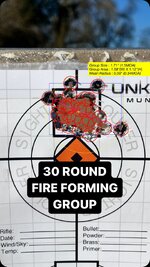n8outdoors
FNG
- Joined
- Nov 4, 2023
- Messages
- 8
I can't be the only one wondering if its my rifle, or my expectations.
I am only explaining the rifles I have to highlight the progression of inexpensive to higher end, with seemingly no improvement in accuracy... Which is annoying.
I have a used Savage 110 Hunter in 22-250 with a middle of the road Vortex scope... tack driver with 1/4" capability and an average extreme spread (ES) of 1" with no wind. I also have my first big game rifle from 2009 which is a 1st gen Ruger American in 270 win with an inexpensive Leupold scope. Again, very accurate, maybe 3/4 MOA with average ES 1.2". Fast forward to 5 years ago and ordered a (fancy for me) Weatherby Mark 5 Back Country Ti, Leupold Mark 5 scope with Harris Bipod. Accurate rifle, but no more so than my 1st 2 "inexpensive" rifles. I am now testing factory loads for my newest rifle, a Tikka T3X RoughTech in 7mm RM with a Trijicon TenMile scope (Thanks Rokslide for data leading to that decision), SRS Break, Limbsaver recoil pad, MDT Bipod. As easy to shoot and spot as my 22-250. I have shot every factory load I can get my hands on for that rifle minus Norma Bondstrike, HSM Berger VLD and Underwood Nosler Accubond which should be here next week.
For testing, I shoot 5 shot groups, 4 targets (20 rounds), cooling between groups, and measure extreme spread. So far, best 5 shot group is 0.6", however the average on that load (162g ELDX) accross the 20 round test is 1.3". Side Note: I dont really want to hunt with ELDX from horror stories.
Next closesed is Barnes 160g TSX with best group 1.0" and 20 round ES 1.7".
I constantly see post/ media "1/4 MOA all day" bla bla bla. I could claim from my tests, that my T3X is a ".6 MOA rifle"... It can be, but its not. I am aware, I can get more accuracy if I hand load...
Questions:
1) What is your expecatation for an accurate rifle?
2) Are smaller calibers like the 22-250 inherently more accurate than say .284 bullet?
3) Anyone else watch numerous MOA challenges on youtube and feel vindicated against seemingly endless claims of "sub moa"?
I am only explaining the rifles I have to highlight the progression of inexpensive to higher end, with seemingly no improvement in accuracy... Which is annoying.
I have a used Savage 110 Hunter in 22-250 with a middle of the road Vortex scope... tack driver with 1/4" capability and an average extreme spread (ES) of 1" with no wind. I also have my first big game rifle from 2009 which is a 1st gen Ruger American in 270 win with an inexpensive Leupold scope. Again, very accurate, maybe 3/4 MOA with average ES 1.2". Fast forward to 5 years ago and ordered a (fancy for me) Weatherby Mark 5 Back Country Ti, Leupold Mark 5 scope with Harris Bipod. Accurate rifle, but no more so than my 1st 2 "inexpensive" rifles. I am now testing factory loads for my newest rifle, a Tikka T3X RoughTech in 7mm RM with a Trijicon TenMile scope (Thanks Rokslide for data leading to that decision), SRS Break, Limbsaver recoil pad, MDT Bipod. As easy to shoot and spot as my 22-250. I have shot every factory load I can get my hands on for that rifle minus Norma Bondstrike, HSM Berger VLD and Underwood Nosler Accubond which should be here next week.
For testing, I shoot 5 shot groups, 4 targets (20 rounds), cooling between groups, and measure extreme spread. So far, best 5 shot group is 0.6", however the average on that load (162g ELDX) accross the 20 round test is 1.3". Side Note: I dont really want to hunt with ELDX from horror stories.
Next closesed is Barnes 160g TSX with best group 1.0" and 20 round ES 1.7".
I constantly see post/ media "1/4 MOA all day" bla bla bla. I could claim from my tests, that my T3X is a ".6 MOA rifle"... It can be, but its not. I am aware, I can get more accuracy if I hand load...
Questions:
1) What is your expecatation for an accurate rifle?
2) Are smaller calibers like the 22-250 inherently more accurate than say .284 bullet?
3) Anyone else watch numerous MOA challenges on youtube and feel vindicated against seemingly endless claims of "sub moa"?

